Bookware
Bookware Overview
Campus Retail Solution
The Bookware Bookstore Management Solution is a complete inventory management, point of sale, and e-commerce solution specifically designed for Canadian university and college retail.
Bookware's complete integration between all aspects of the system enables you to manage campus retail more efficiently, increasing productivity and profitability.
Bookware provides you with a solution that increases cost effectiveness and improves customer service.

Features

Easy-to-use graphical interface

Campus focused

Canadian tax codes

Multi-currency

Multi-store/warehouse

Available as a hosted/cloud application

Full suite of reports, exportable to PDF and Excel

Accounting interfaces with PeopleSoft, Datatel, Banner, and Others

Fully integrated with system-wide real time updates

Inventory
Bookware allows you to easily create items and specify item-specific attributes, such as item-specific return policies or multiple quantity ordering. At every level Bookware supports both general merchandise and textbook items, including integrated support of new, used, and digital copies of textbooks.
Once an item has been created, it is available for use throughout the system. Each item is tracked as it moves through the purchasing process, and the item history is easily accessible.
Inventory counts are performed using scanners and barcoded count sheets. Detailed inventory reports can be printed for count discrepancies as well as sell-through analysis and profit reports.
Features

Customizable reports

Perpetual inventory

Access code & e-book support

Image support

Multiple departments and warehouses

Audit trail of stock movement

Sales analysis

Scanable inventory counts

Item data export

Course Planning
The Course Planning program enables you to easily create an organized course structure to which you can assign textbooks and course materials, facilitating ordering for each term. Bookware calculates what percentage of enrolled students have purchased the item for a course in the past and displays this sell-through analysis when each item is assigned to a course to help your course planners make their buying decisions.
When the courses and materials have been entered, Bookware generates requisitions for the materials according to course, department, term or campus.
Course Planning is integrated with Booksaurus, a used book buy-back program, so that any used books which are required for courses can be bought back by your cashiers through BookwarePOS.
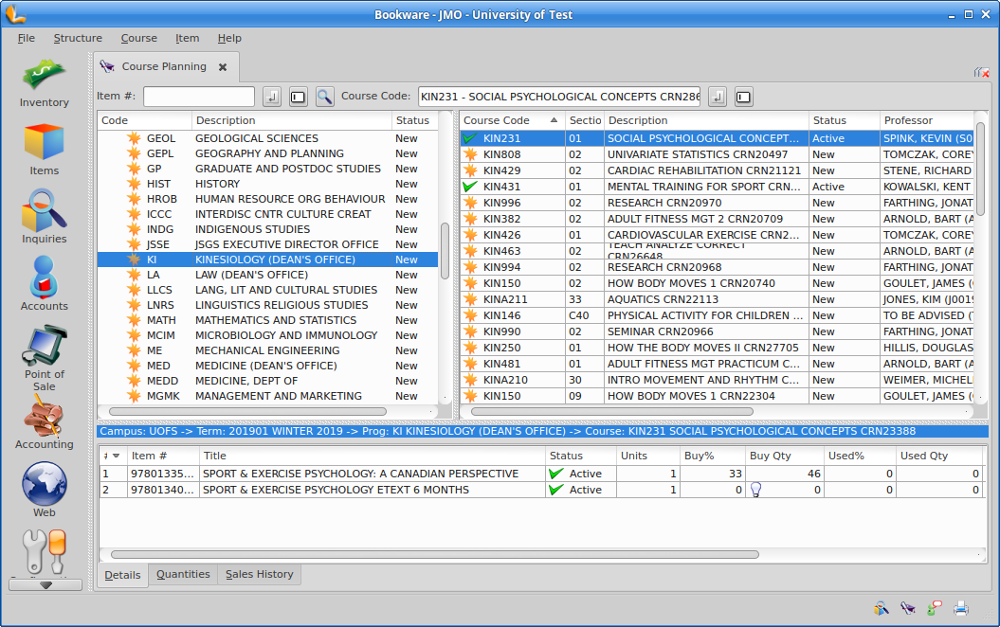
Course Planning Features

Multi-level course structure

Supports e-books and access codes

Shelf lists

Integrated with the Requisitioning program

Historical sell-through analysis

Email the instructor from Course Planning

Shelf labels

Requisitioning
The Requisitioning program allows you to create, edit, and approve requisitions for inventory items. Bookware automatically generates requisitions from Point of Sale (when an item's minimum inventory level is reached), Course Planning (to purchase books for an upcoming term), Receiving (when an item is re-ordered because of a short shipment), and the Customer Orders program (when an ordered item is not in stock). Requisitions can also be generated manually.
When requisitions are generated they are sorted by vendor and appear in an easy-to-read summary for each vendor. When the requisitions have been approved they are converted into purchase orders and appear in the Purchasing program.
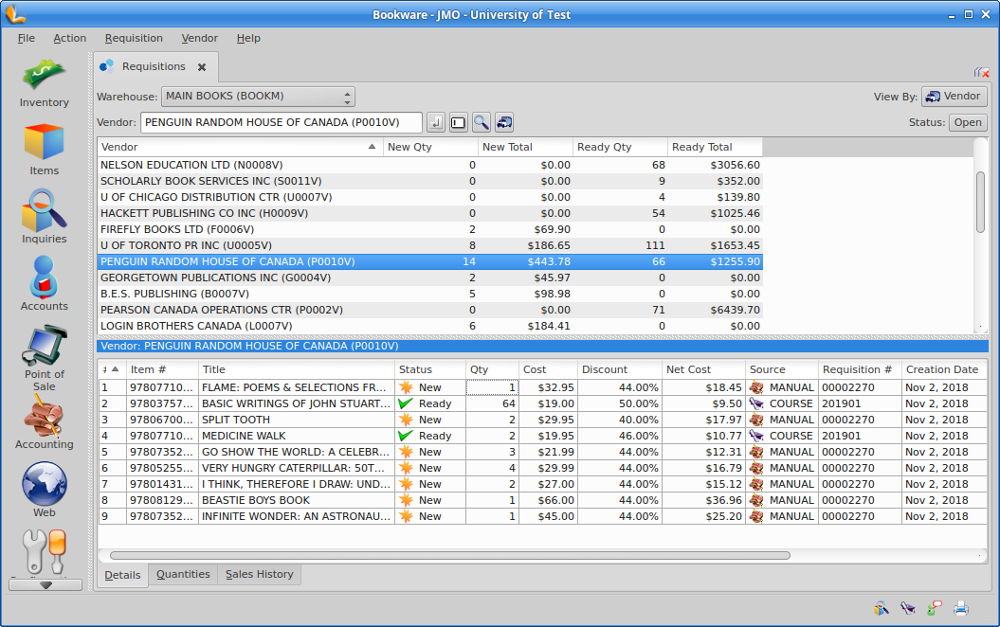
Requisitioning Features

Automatically or manually generated

Consolidated by vendor

Require management approval

Integrated with the Course Planning and Purchasing programs
Purchasing
The Purchasing program provides an overview of all vendors and their purchase orders. A summary of all outstanding purchase orders, either not-yet-sent or not-yet-received, is displayed for each vendor. Purchase orders which have already been received are archived and easily viewable, when desired.
Purchase orders can be created, viewed, and edited from the Purchasing program. If the purchase order is edited after it has been sent, Bookware will alert you to the changes, so that you can send an updated purchase order to the vendor.
Purchase orders can be printed, or sent directly from the Purchasing program by email as a PDF. When all items have been fully received, the purchase order is automatically closed by Bookware.
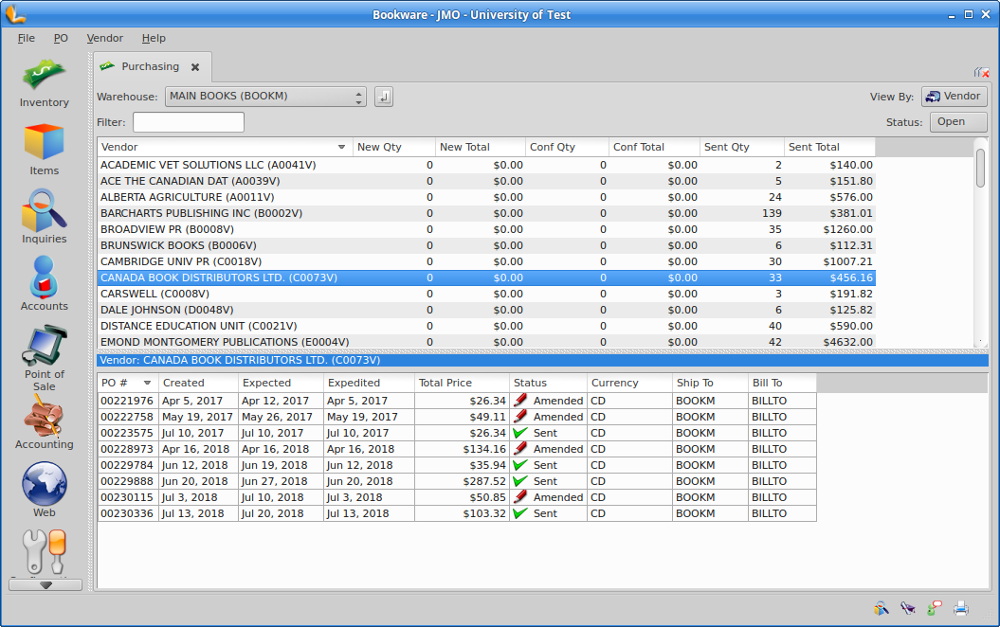
Purchasing Features

Consolidated by vendor

Send POs by email

Supports both textbooks and general merchandise

PO closes when fully received

Integrated with Requisitioning and Receiving programs

Closed POs are easily viewable

Receiving
The Receiving program completes the purchasing process by moving the items from the purchase order to inventory. When a shipment is received, it is matched to its purchase order and all shipment and invoice information is recorded for the received items.
When the items are received, Bookware updates the inventory throughout the system, including automatic price changes at POS. Barcoded labels are easy to print for all items which require them.
Bookware notifies you if any items are received for a customer order, and a picking list for the order is automatically printed. Short-shipped and damaged item reports are also generated from the Receiving program, when necessary.
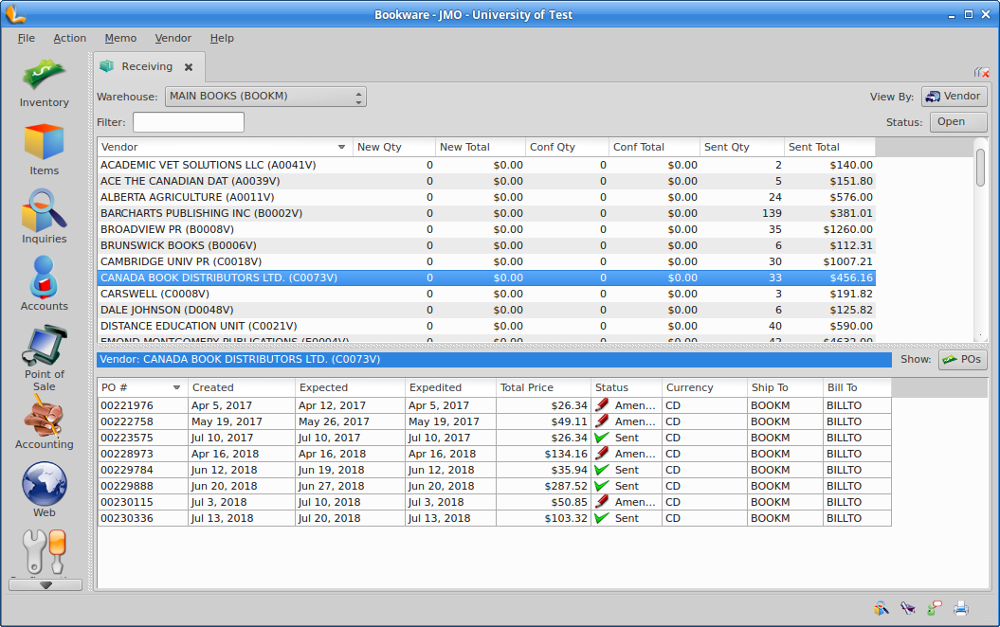
Receiving Features

Immediate system-wide inventory updates

Barcoded labels

Short-shipped and damaged item reports

Picking list for customer orders

Profit margin protection

Integrated with Purchasing and Returns programs

Past receiving memos are easily viewable
Customer Orders
The Customer Orders program is used to create and process customer orders: picking lists, packing lists and invoices are all generated for each customer order. Requisitions are automatically created for customer order items which are not in stock. When an item is received for a customer order, the receiver is notified that an allocated item is included in the shipment, and a picking list is printed from Receiving in order to fill the customer order.
The Customer Orders program is integrated with the eSolution e-commerce software such that any orders which are placed on your website appear automatically in the Customer Orders program. When ready to ship, the web order is processed through POS which contacts the online payment gateway for completion of the transaction payment. Once the transaction is completed, a shipping notification is sent from POS to the customer.
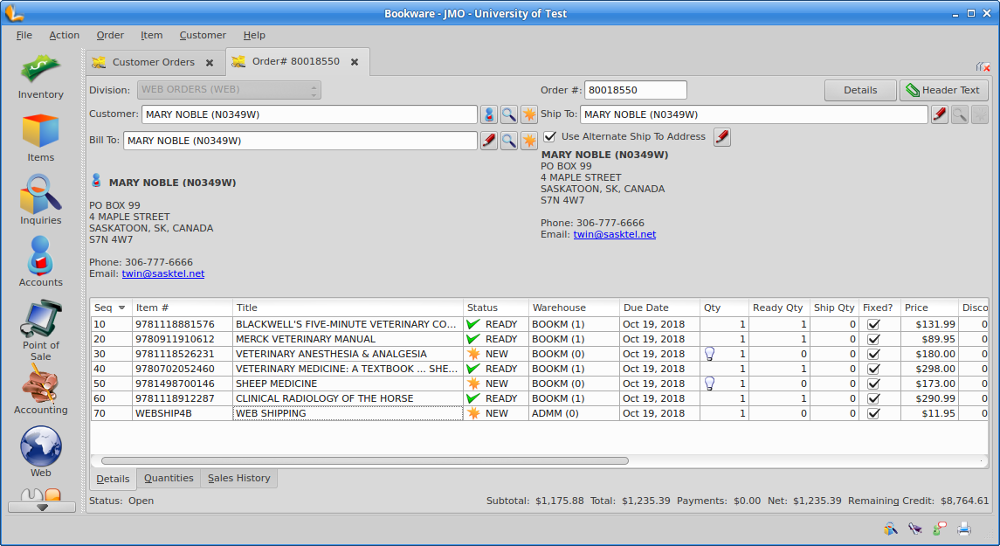
Customer Order Features

Automatic requisitions for order items

Automatic allocation of order items

Barcoded picking lists

Packing slips and invoices

Integrated web orders

PCI compliant web order payment through an online payment gateway

Return Processing
The Returns program manages the return of items to each vendor. Returns can be created manually or through the returns worksheet. The returns worksheet accesses the vendor's return policy and compares the invoice date for each item from the vendor to the length of time the item has been in stock. All items which are listed on the returns worksheet can be selected and automatically added to a return memo for the vendor.
A summary of all outstanding return memos is displayed for each vendor, and the progress of each return memo (eg. items have been shipped, but no credit received) is tracked by Bookware. Return memos for which you have already received credit are archived and easily viewable, when desired.
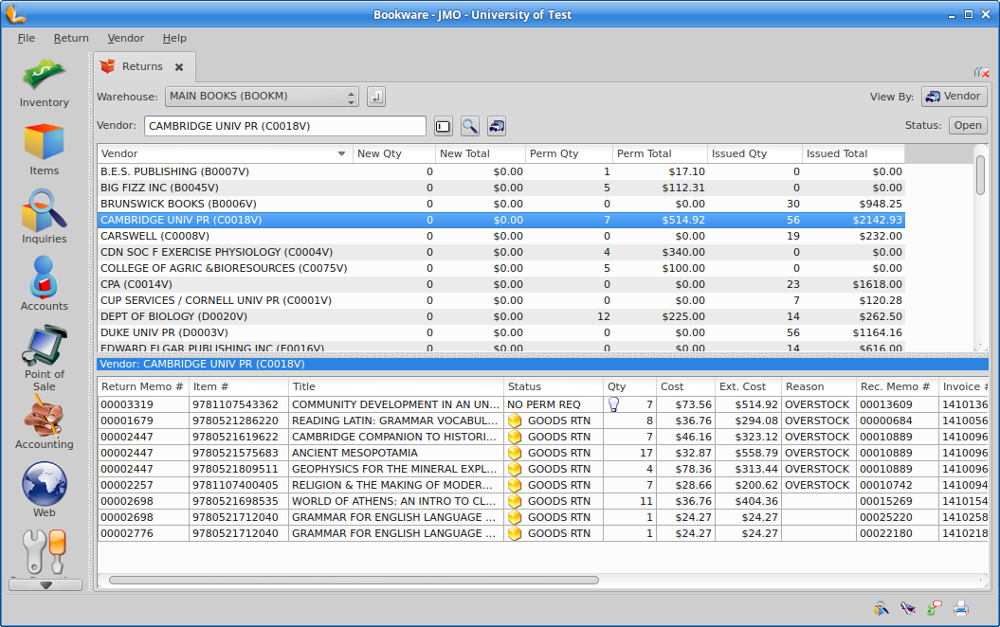
Return Processing Features

Comprehensive returns worksheet

Integrated vendor return policies

Minimum return levels

Permission, extension and expedite letters

Picking and packing lists

Damaged goods follow-up

Optional item-specific return policies

Digital Products
Access codes, e‑books, and digital resources are fully supported by Bookware. Digital products can be adopted by an instructor for a course. In Course Planning, the digital product can be flagged as an alternative to the physical textbook.
Bookware provides access cards which can be printed for selling access codes in store. When a digital product is purchased, BookwarePOS contacts the digital content provider in real time to retrieve an access code. The PIN code and access instructions are printed on the customer's receipt.
On your eSolution website, digital products appear in the course search results along with the physical textbooks assigned to the course. If the customer attempts to purchase both the digital product and physical book, the eSolution will warn them that they are purchashing duplicate texts. Upon completion of transaction payment, the access code and instructions are immediately emailed to the customer.
Digital Product Features

CampuseBookstore (CEI), VitalSouce, Willo Labs, and Texidium

Automatic retrieval of PIN code through POS

Access cards for in-store purchases

PIN code refund support

Automatic email of PIN code for online sales

All digital product sales are recorded and reportable

Events
Bookware's Events Management program allows you to create and manage multiple events across multiple venues. Events can be booking-type events, such as career fairs with reserved booths, or ticket-type events such as concerts or book readings. For each event, you can set complex capacities and pricing, such as multiple booking/ticket types (such as large booth/small booth or member/non-member or adult/student/child).
Event admission (bookings/tickets) can be purchased in person at POS or online through your website. When purchased in person, a physical ticket can be generated and printed for the customer from a designated ticket printer. When purchased online, the ticket is automatically emailed to the customer after payment has been completed. The ticket displays the event details, your logo, and unique admission barcode.
At the event, the unique ticket barcode is scanned to validate the ticket. Ticket validation is via a web based app and can be performed with the standard POS, with Mobile POS, or with a mobile device and a Bluetooth scanner.
Events Features

Complex capacities and pricing

Multiple ticket types, such as member/non-member, adult/student/child

Merchandise or services can also be associated with the event

Ticket redemption with BookwarePOS or Mobile POS

Scan a printed ticket or digital ticket on a mobile device

Unique barcode on each ticket

Student Credit Management
The Sponsored Students program enables you to create student and sponsor accounts. For each sponsored student account, you can specify the credit limit and any purchase restrictions on the account.
At POS, the cashier can access the sponsor account using the student's campus ID card. BookwarePOS will automatically enforce the credit limit and any purchase restrictions. When the purchase is completed, the credit limit for the account is automatically updated and an itemized invoice is automatically generated in Bookware for the transaction.
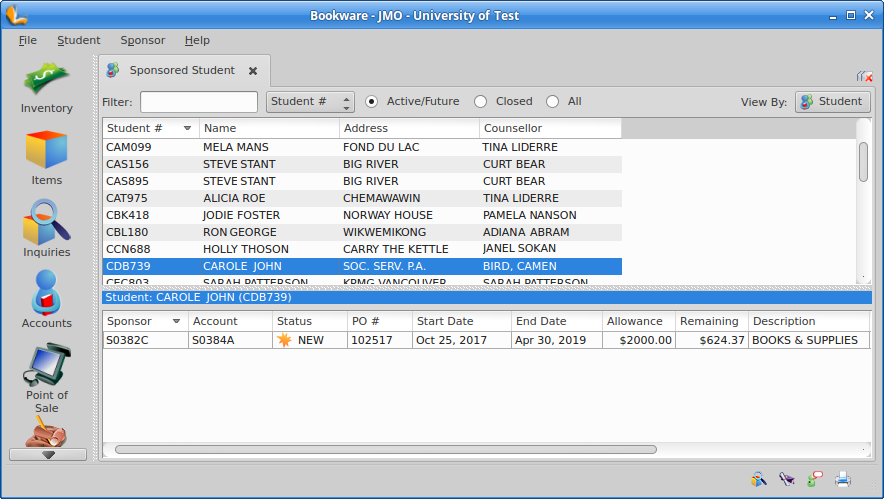
Student Credit Features

Easy set up of students and sponsors

Account access at POS using student ID or barcoded account cards

Credit limit and purchase restrictions enforced at POS

Itemized sponsor invoices

Student allowance report

Customer report by business class

Accounting
The Accounting program processes all changes in inventory and produces up-to-date and accurate account profiles. Accounts Receivable, Accounts Payable, and General Ledger are all included in Bookware Accounting, enabling you to: reconcile your cash daily, edit the exchange rate, reconcile bank statements, run a trial balance, prepare your GST and PST returns for the government, and reconcile vendor return credits, invoices and payments.
Bookware also supports accounting integration with several third-party accounting systems including PeopleSoft, Banner, Datatel, and Great Plains.
Accounting Features

Multi-currency support

Canadian taxes

Daily cash reconciliation

Multiple account trial balance

Adjustable year-end

Multiple store support

Optional GL data export
Document Server
The Bookware Email Document Server is a product designed to increase staff productivity and efficiency. The Document Server allows users to email Bookware documents directly from Bookware: no printing of documents required.
Using the Document Server users can easily send the most frequently printed documents: Purchase Orders, Purchase Order Expedite letters, Returns Memos, Returns Permission letters, Returns Expedite letters, and Returns Extension letters.
The user can add customized messages to the body of the email. The transmission log allows you to monitor the status of your emails.
Document Server Features

Direct transmission of documents from Bookware

Documents transmission log

Template email body text

Kitting
The Kitting program enables your store to easily assemble inventory packages, making it an ideal tool for creating course packs, selling computers assembled in-store or including a bonus product with purchase.
The Kitting program manages the ordering and inventory for all the component pieces for that kit. When a kit needs to be built, Kitting will produce a picking list for all the component pieces which the final product requires.
With the Kitting program inventory replenishment can be controlled by setting minimum inventory levels for components, final products are tracked by the Inventory program, and projection reports can be created to determine how many kits will be needed and therefore how many component pieces need to be ordered.
The kitting process is completely reversible: a final product can be "unbuilt" and all the component pieces returned to inventory for individual sale, for use in other kits, or for return to a supplier. Kit reversal is also a useful feature when pre-stocked displays are received in store. The display can be defined as a kit of component parts and then "unbuilt" into those parts for better inventory tracking.
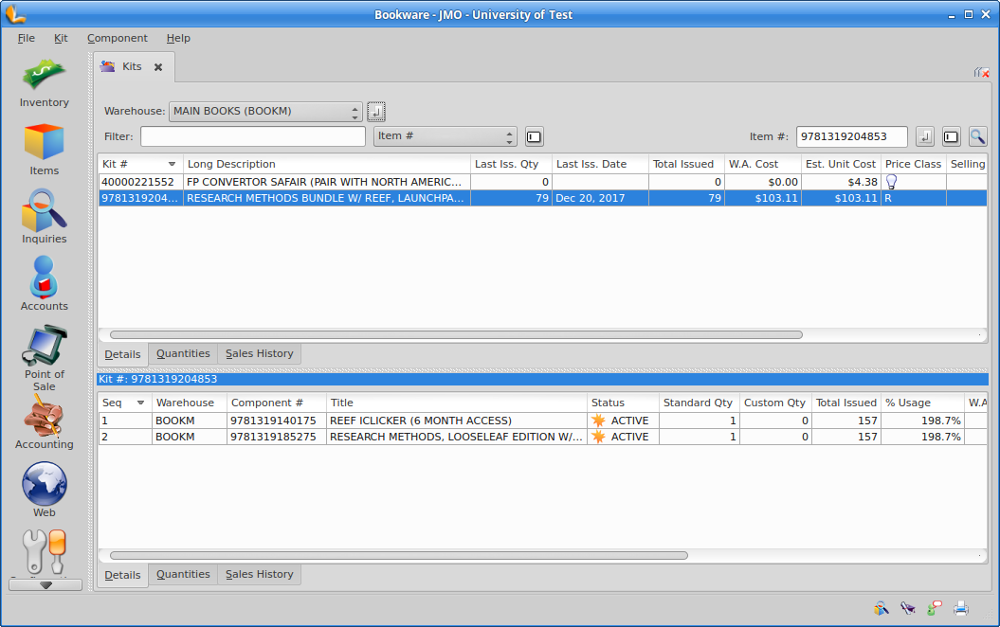
Kitting Features

Builds packages with multiple components

Automatically produces a picking list

Updates inventory for each component

Includes customizable kit templates

Kits are completely reversible

Fully integrated with Requisitioning, Purchasing, Inventory, and e‑Commerce

